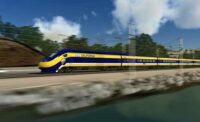California High Speed Rail Authority�s share of the latest round of stimulus funds came with specific directions: The $715 million had to be spent in the Central Valley, to either start construction on the Merced-Fresno or Fresno-Bakersfield leg of the 800-mi, $45-billion project.
Authority board members stressed that despite the Federal Railway Administration suggestions of where to direct the funds, they would use a pre-established formal criteria to determine where to begin building the rail infrastructure based on land acquisition, progress on environmental work and other factors.
�It is absolutely critical that we invest these funds where they will do the most good � and position California to ultimately create a true high-speed rail system that connects major cities to one another,� says new authority Executive Director Roelof van Ark, in an Oct. 18 statement announcing the criteria.
The authority plans to make decisions about how to start by the end of 2010, complete all environmental reports by 2012, shape the design-build contracts in early 2012 and start construction after that, according to spokesperson Rachel Wall.
The first phase from San Francisco to Los Angeles could be complete by 2020, but some sub-sections could be put into service earlier.
California also received $16 million for improvements to the Caltrain station at the Transbay Transit Center in San Francisco.
In the last round of funding, California received $2.25 billion of the $8 billion awarded, bringing the total available funding for starting the project to $4.3 billion, including matching dollars from a $9 billion 2008 state bond measure along with local funds. Program Manager, Parsons Brinckerhoff of New York, has been working on environmental phase since 2008.
The available funding total incorporates the authority�s January 2010 American Recovery and Reinvestment Act federal funding award, matched dollar-for-dollar with state funds, and last week�s award of $715 million matched with an additional 30% in state funding.
�The Central Valley is indeed key to creating the core of a true high-speed rail system in California, as that is where our trains will travel truly high speeds of 220 miles per hour,� says van Ark. �But no matter where we start building, the goal remains the same: a statewide high-speed rail system up and running in 2020 connecting the Bay Area with the metropolitan area of Los Angeles and Anaheim, that creates thousands of jobs, improves air quality, and provides us all with a cheaper, faster and more convenient way to travel.�
The legal requirements include meeting the federal deadline of fall 2017 for completing construction and �operational independence� � meaning quantifiable benefits such as improved travel reliability, reduced travel time, or more frequent intercity rail service, even if the overall high-speed rail system is not completed.
Other factors proposed for consideration include ensuring that the first segment built forms the core of a statewide system; building the most useful high-speed train infrastructure at the lowest cost; and any other factors, including potential litigation, that could delay construction.
The authority board is scheduled to select the project section that is first to be constructed at its December meeting. The selection of a heavy maintenance facility will not be a part of that decision, and will not be decided until after the environmental review process has been completed.



